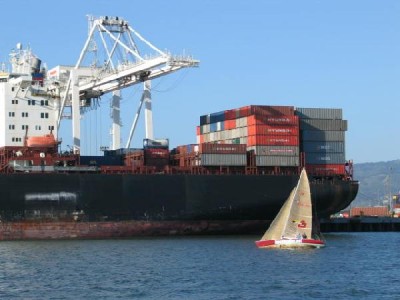Ports and Cargo Data
The visualization below shows graphs of trends of cargo moved through US ocean ports. By default, the graph shows top 5 states for ocean cargo. Users may view the top 5 ports in the US by selecting that option in the "state" pulldown menu. Users can also look at cargo trends by state or they can examine specific ports. Users may also change the graph variable to examine trends in Tota Value, Total Weight, Import Value, Import Weight, Export Value, Export Container Value, and Export Container Weight. For more information on how to use the NOEP Apps, view the manual.
Ports and Cargo Facts
NOEP presents the Ports and Cargo section because Seaports are an important part of the ocean and coastal economies. Whether people live inland or along the coast, they are dependent on US ports and maintaining healthy coasts that support them:
- Nearly all of the country’s overseas cargo moves through nation's ocean ports: 77.4 percent or $4.6 trillion out a total trade value of $6 trillion .*
- From 2019 to 2022, ports moved over $90 billion of goods each month. By summer of 2022, monthly volumes approached $200 billion per month.*
- As the value of goods moved increased, the volume of cargo has declined. From 2019 to 2021 volumed declined by about 5.8 percent or 6 million TEU. *
- Seaports support employment of > 31million people in the U.S. **
- Port activities generate $5.4 trillion in economic activity annually. **
Ports provide multiple services to the public: they are the nexus for business transactions for imported and exported goods; they serve as environmental stewards of our coastlines, spending millions of dollars annually to minimize impacts of port operations on their surrounding communities and natural resources; and they serve as local economic engines, generating jobs and opportunities that allow businesses to flourish.
*Patricia S. Hu, Rolf R. Schmitt, Ramond Robinson, Matthew Chambers, William H. Moore, Alpha Wingfield. 023 Port Performance Freight Statistics Program: Annual Report to Congress. United States Department of Transportation. 2023. https://rosap.ntl.bts.gov/view/dot/65990
** American Association of Ports Authorities: https://www.aapa-ports.org/advocating/content.aspx?ItemNumber=21150
Ports Data Methods
 Data for NOEP's Ports and Cargo section are extracted from the import and
export "Port" data series produced by the
Foreign Trade Division of the US Census Bureau.
The collection and publication of U.S. foreign commerce and trade statistics
has been the responsibility of the Department of Commerce since 1905 and is
assigned to the Census Bureau.
Data for NOEP's Ports and Cargo section are extracted from the import and
export "Port" data series produced by the
Foreign Trade Division of the US Census Bureau.
The collection and publication of U.S. foreign commerce and trade statistics
has been the responsibility of the Department of Commerce since 1905 and is
assigned to the Census Bureau.
Data on most US exports are controlled and collected by the Census Bureau. Exceptions are made for exports to Canada, which are represented by agreement from Canadian import data, and for defense military and certain foreign aid shipments and pass through shipments, which are not included in the data. Export data contain the codes for the originating port, the final destination country, and the trade good or commodity, and the weights and dollar values for each type of shipment (air, vessel, and container).
Import data are collected and compiled by the Census Bureau from the US Customs Service systems for most shipments to the US. Exceptions are made for returns of military and other government agency goods and supplies, monetary gold and silver, monetary coinage, and shipments en-route to other countries. The import data include codes for the receiving port, the originating country, and the commodity, and the cargo weights and dollar values by type of shipment.
NOEP filters these data to include only marine based shipments and summarizes them by year, port, and major commodity categories. The summarized data, from 1997 to the most current year, are made available on this website. These can be queried from our database by year, state, and port. Additional query options include country of origin or destination and major cargo type.

